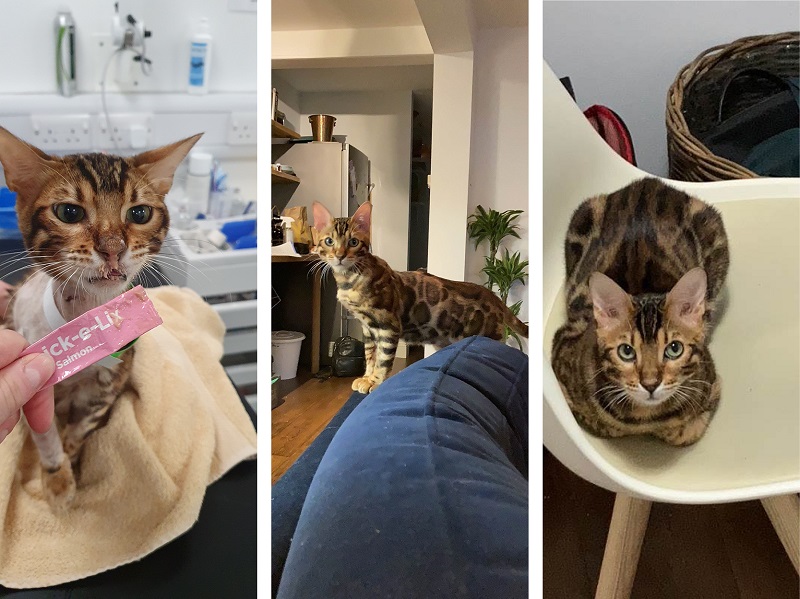Successful Feline Infectious Peritonitis Treatment with Remdesivir
Clinical Connections – Spring 2022
Merlin, a 24-week-old male neutered Bengal cat, was referred to the Queen Mother Hospital for Animals (QMHA) with a one-week history of lethargy, hyporexia and a 24-hour history of tachypnoea.
He was the first of more than a dozen cats with feline infectious peritonitis (FIP) to be successfully treated with remdesivir at the RVC.
Feline infectious peritonitis is an uncommon disease caused by a mutated enteric coronavirus. When diagnosed, the disease was thought to be almost always fatal due to a lack of efficacious treatment. Over the past few years, a small number of studies showed that an antiviral drug remdesivir and its parent nucleoside GS-441524, could be the key to successfully treating FIP in cats. However, it wasn’t until the COVID-19 pandemic, when remdesivir became licensed to treat COVID-19 infections in human patients, that the drug became widely accessible to treat FIP here in the UK and Australia.
On presentation Merlin was pyrexic (40oC), with palpable abdominal masses and a pleural effusion requiring thoracocentesis. Serum biochemistry revealed mild hypoalbuminemia and moderate hyperbilirubinemia.
Haematological examination revealed moderate monocytosis and a marked neutrophilia with left shift and moderate toxicity. CT of his thorax and abdomen demonstrated bilateral pleural effusion, with pleuritis and multifocal lymphadenopathy. Fine needle aspirates of abdominal lymph nodes were consistent with pyogranulomatous inflammation and the pleural fluid was a protein-rich transudate (59g/L) with an A:G ratio of 0.5 and positive coronavirus titre.
Merlin’s case was complicated by the presence of severe phlebitis of his right cephalic vein from previous catheter placement, resulting in extensive necrosis of the overlying skin. He required skin debridement under general anaesthesia and antibiotic treatment.
While hospitalised, Merlin’s condition unfortunately deteriorated. He developed peritoneal effusion and became recumbent, obtunded, oxygen-dependent and his pleural effusion required repeat thoracocentesis. A diagnosis of FIP was suspected, and his owners opted to start treatment with remdesivir.
Treatment and outcome
Merlin started treatment with 15mg/kg remdesivir intravenously. 24 hours after starting treatment, his pleural effusion increased in volume and he required repeat thoracocentesis. After 36 hours, Merlin remarkably appeared brighter, he was no longer oxygen-dependent and began eating. By 48 hours he was bright, vocal and active and was transferred out of the ICU. By 72 hours there was significant reduction in both pleural and peritoneal effusions.
By day-five Merlin’s pleural effusion had resolved, and he was transitioned onto 10mg/kg subcutaneous remdesivir injections. By day-seven his peritoneal effusion had resolved, and he underwent a general anaesthetic and surgical repair of his extensive right forelimb wound. He recovered well from the procedure and two days later Merlin was discharged to complete an 84-day course of subcutaneous remdesivir injections at home. His wound healed completely with no complications, and he tolerated his daily remdesivir injections well.

It is now several months after Merlin finished his treatment and he has been doing brilliantly at home.
Commenting on Merlin’s case and other cats treated for FIP at RVC Small Animal Referrals, Jodie Green and Sarah Tayler, both of the Internal Medicine Service, said: “Thirteen cats have now followed in Merlin’s footsteps and the results have been astonishing. Cats we were worried were almost too severely affected have shown dramatic recoveries within just two to three days of starting treatment. Six months ago, we would have considered this a completely fatal disease and now we’re achieving treatment success rates of over eighty percent.”
They added: “After Merlin finished his treatment a new drug in the form of a tablet became available (GS-441524). This appears to be just as effective as remdesivir and negates the need for daily subcutaneous injections. After initial intravenous remdesivir therapy, we have transitioned cats onto the oral tablet with equal success.”
